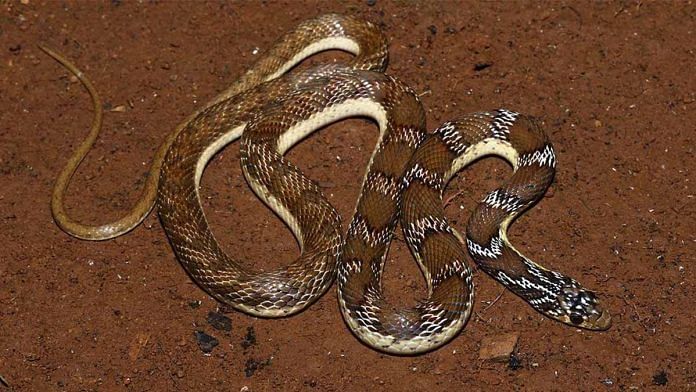New species of snake in Tamil Nadu discovered from 185-year-old paintings
An international team of scientists have discovered a new snake species from Tamil Nadu, which had been confused with a similar species for over a century, through nearly 200-year-old paintings.
First collected in the mid-19th century, the new species, now known as Joseph’s racer, had been misidentified as the bended racer or Argyrogena fasciolata, which is found across India.
This confusion can be traced back to British scientist Albert Günther, who worked at the UK Natural History Museum between 1875 and 1895, and mixed up the two species while studying snake skins collected in 1796.
However when Dr Deepak Veerapan, a museum associate from Germany, was given a snake, he realised that it looked different from the ones found in Tamil Nadu.
The researchers referred to a series of natural history paintings produced in 1836 by a Danish physician and zoologist named Theodore Cantor. Cantor worked for the British East India Company and was the first western scientist to collect and scientifically describe many species, including the Siamese fighting fish and king cobra, in incredibly detailed accounts.
A study of his 185-year-old paintings revealed that the snakes in them were misidentified. With the investigation into the paintings, coupled with reassessing over 400 different accounts of the snake, the researchers confirmed that the racer was not just a single species as had long been thought.
Joseph’s racer or Platyceps josephi has been found to have a much more restricted distribution and are found only in Tamil Nadu, which could have an impact on the snake’s conservation. Read more here.
Also read: 80,000-yr-old child grave in Africa is oldest evidence of human burial
NASA’s Voyager 1 beams back sound of interstellar gas beyond the solar system
Voyager 1, a NASA spacecraft launched 44 years ago and now the most distant human-made object in space, has detected the constant drone of interstellar gas or plasma waves.
The spacecraft has passed the edge of the solar system through the heliopause — the solar system’s border with interstellar space — into the interstellar medium (matter and radiation that exists between star systems).
Examining data beamed back from more than 14 billion miles away, researchers uncovered the faint monotone of the interstellar gas.
This will allow scientists to understand how the interstellar medium interacts with the solar wind, and how the protective bubble of the solar system’s heliosphere (space that surrounds the Sun) is shaped and modified by the interstellar environment.
Launched in September 1977, the Voyager 1 spacecraft flew by Jupiter in 1979 and then Saturn in late 1980. Travelling at about 38,000 mph, Voyager 1 crossed the heliopause in August 2012.
Read more about this here.
Herbivores developed powerful jaws to digest tougher plants after mass extinction
Plant eaters survived a mass extinction that wiped out 90 per cent of the world’s species 252 million years ago by learning to eat different kinds of plants, a new study has found.
The study from the University of Bristol found that the species that were able to chew harsher materials, which reflected the dry conditions of the era, became the most successful. These tougher herbivores included some of the first dinosaurs.
Following the largest mass extinction of all time, known as the end-Permian mass extinction, ecosystems rebuilt from scratch about 252–201 million years ago, paving the way for new species.
The team measured hundreds of fossil jaws and compared their shapes with living animals. This enabled them to estimate key functional values from the fossil jaws such as mechanical advantage and bite force, measuring the leverage of the jaws and how fast or forcefully they could shut.
Read more here.
Also read: World’s oldest water found in Canada, Oxford researchers say it dates back 1.6 billion years
Brain chip allows paralysed man to type with his mind
A 65-year old man with full-body paralysis was able to type with his mind, with the aid of a new software that turns ‘mental handwriting’ into on-screen words and sentences.
Using just his mind, the man was able to communicate by text at a speed that rivalled smartphone texting by able-bodied individuals.
Stanford University researchers implanted a device, called a brain-computer interface, into the man’s brain. This device was coupled with an artificial-intelligence software, which was able to decode information from the device to quickly convert the man’s thoughts about handwriting into text on a computer screen.
This technology could pave the way for millions globally, who’ve lost the use of their upper limbs or their ability to speak due to spinal-cord injuries, strokes or Lou Gehrig’s disease.
Read more about this here.
Dual vaccination prevents allergic asthma in mice
Scientists have found that dual vaccination against a pair of immune signalling molecules can protect against allergic asthma for at least 11 weeks in mice.
The study could help in protecting patients of asthma, which is the most common chronic lung disease, At least 50 per cent of asthma patients have a form of inflammation in their lungs. The immune signature includes the production of two immune signalling molecules called cytokines — interleukin-4 (IL-4) and interleukin-13 (IL-13) — which are thought to act in early and late-stage asthma respectively.
The researchers designed a pair of vaccines called kinoids that would target these cytokines. Kinoids enable the body to produce an antibody response against cytokines.
After vaccination, the mice showed increased lung elasticity and resistance, compared to the mice given a saline injection. This effect was also seen when the individual vaccines were used separately, but the greatest effect was noted when they were both used. Pair-vaccinated mice also showed 21-fold reduced levels of immune cells in their lungs.
The efficacy of these findings will need to be confirmed in human studies before any major claims can be made about the dual vaccine platform’s potential.
Read more here.
(Edited by Rachel John)
Also read: Indian jumping ants shrink their brains trying to become queen






